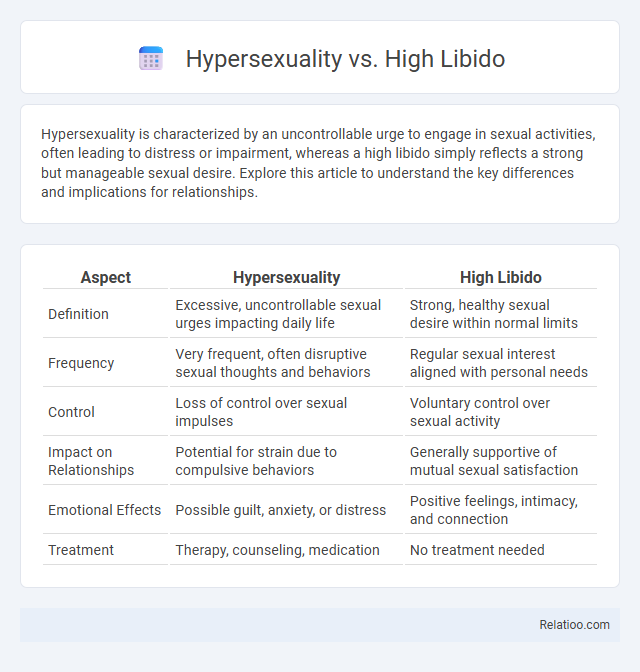Hypersexuality is characterized by an uncontrollable urge to engage in sexual activities, often leading to distress or impairment, whereas a high libido simply reflects a strong but manageable sexual desire. Explore this article to understand the key differences and implications for relationships.
Table of Comparison
| Aspect | Hypersexuality | High Libido |
|---|---|---|
| Definition | Excessive, uncontrollable sexual urges impacting daily life | Strong, healthy sexual desire within normal limits |
| Frequency | Very frequent, often disruptive sexual thoughts and behaviors | Regular sexual interest aligned with personal needs |
| Control | Loss of control over sexual impulses | Voluntary control over sexual activity |
| Impact on Relationships | Potential for strain due to compulsive behaviors | Generally supportive of mutual sexual satisfaction |
| Emotional Effects | Possible guilt, anxiety, or distress | Positive feelings, intimacy, and connection |
| Treatment | Therapy, counseling, medication | No treatment needed |
Understanding Hypersexuality and High Libido
Hypersexuality is characterized by an excessive or uncontrollable desire for sexual activity that can lead to distress or impairment, often linked to underlying psychological conditions. High libido refers to a naturally increased sex drive without negative consequences on daily functioning or well-being. Understanding the distinction between hypersexuality and high libido is crucial for identifying when sexual desire crosses into a problematic territory requiring clinical attention.
Defining Hypersexuality: Key Characteristics
Hypersexuality is characterized by an excessive preoccupation with sexual thoughts, urges, or behaviors that significantly interfere with daily functioning and relationships, distinguishing it from a high libido, which denotes a naturally increased sexual desire without negative consequences. Key attributes of hypersexuality include compulsive sexual activities, loss of control over sexual impulses, and resulting distress or impairment in social, occupational, or personal life. Understanding these defining characteristics helps you recognize when sexual desire crosses from healthy expression into problematic hypersexuality.
What Constitutes a High Libido?
High libido refers to a naturally increased desire for sexual activity that varies widely among individuals and is influenced by hormonal levels, psychological factors, and overall health. Unlike hypersexuality, which is characterized by compulsive and often uncontrollable sexual thoughts and behaviors causing distress or impairment, high libido remains within the realm of healthy sexual expression without negative consequences. Understanding what constitutes a high libido involves recognizing normal variations in sexual desire that do not interfere with daily functioning or emotional well-being.
Major Differences Between Hypersexuality and High Libido
Hypersexuality is characterized by an uncontrollable, excessive desire for sexual activity that often leads to distress or impairment, whereas high libido refers to a naturally strong but manageable sexual drive without negative consequences. Unlike high libido, hypersexuality may involve compulsive behaviors, difficulty regulating impulses, and intrusive sexual thoughts that interfere with daily functioning. Understanding these differences is crucial for accurate diagnosis and effective treatment, as hypersexuality may require therapeutic intervention while high libido usually does not.
Psychological Causes Behind Hypersexuality
Hypersexuality differs from a high libido by involving uncontrollable sexual urges often linked to psychological factors such as bipolar disorder, obsessive-compulsive disorder, or trauma history. Psychological causes behind hypersexuality include dysregulation in brain areas responsible for impulse control and emotional regulation, like the limbic system and prefrontal cortex. Your understanding of these underlying causes is crucial for identifying appropriate therapeutic interventions and managing symptoms effectively.
Factors Influencing High Libido in Individuals
High libido is influenced by a complex interplay of hormonal levels, psychological factors, and genetic predispositions, with testosterone playing a pivotal role in sexual desire intensity. Neurochemical imbalances involving dopamine and serotonin can significantly affect libido, while emotional well-being and stress levels contribute to fluctuations in sexual drive. Unlike hypersexuality, which is characterized by compulsive sexual behaviors often linked to mental health conditions, high libido reflects a natural variation in sexual appetite without inherent behavioral dysregulation.
Identifying Signs of Problematic Sexual Behavior
Hypersexuality involves excessive, uncontrollable sexual urges that interfere with daily life, differing from a high libido, which is simply an increased but manageable sexual desire. Identifying signs of problematic sexual behavior includes compulsive sexual thoughts, inability to reduce sexual activity despite negative consequences, and experiencing distress or impairment in social, occupational, or personal functioning. You should seek professional help if sexual behavior starts to dominate your life or causes emotional or relational harm.
Impact on Relationships: Hypersexuality vs High Libido
Hypersexuality often leads to significant relationship challenges due to compulsive sexual behavior that can cause emotional distress and trust issues, whereas a high libido generally reflects a strong but manageable sexual desire that can enhance intimacy. You may find that hypersexuality requires professional intervention to maintain healthy connections, while a high libido typically supports mutual satisfaction and emotional bonding in partnerships. Understanding the difference helps in addressing relationship dynamics and promoting overall well-being.
When to Seek Professional Help
Seek professional help for hypersexuality when sexual urges interfere with daily functioning, cause distress, or lead to risky behaviors. High libido, characterized by frequent sexual desire without negative consequences, typically does not require clinical intervention. Persistent compulsive sexual behavior that disrupts personal relationships or mental health signals the need for assessment by a mental health specialist.
Managing and Maintaining Healthy Sexual Well-being
Managing hypersexuality involves recognizing excessive sexual behavior that disrupts daily life, whereas a high libido reflects a naturally increased sex drive without negative consequences. Your approach should include setting clear boundaries, seeking professional therapy, and cultivating mindfulness to maintain healthy sexual well-being. Prioritizing open communication and self-awareness supports balanced intimacy and emotional health.

Infographic: Hypersexuality vs High Libido
 relatioo.com
relatioo.com